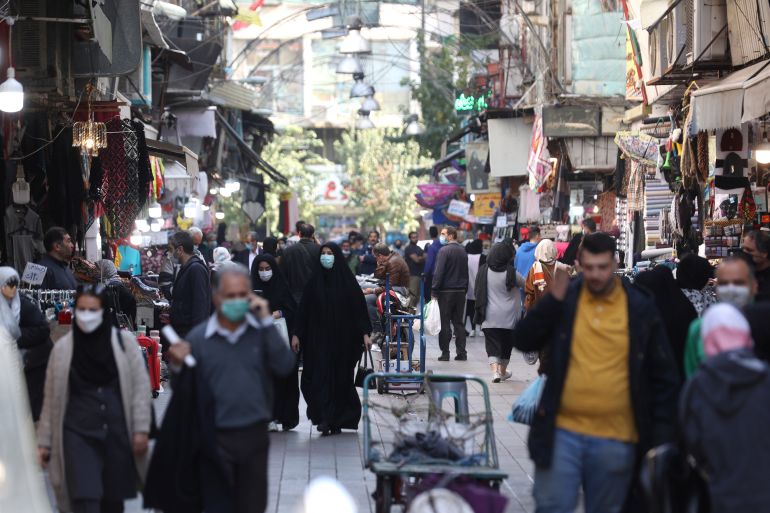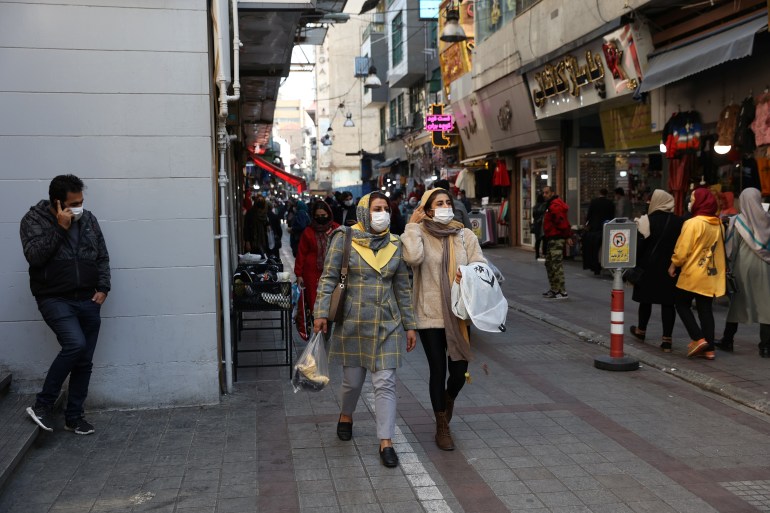Iran’s economy reveals power and limits of US sanctions
United States sanctions drove Iran into a two-year recession. The economy is now growing, but the upside is limited.

Tehran, Iran – As economists, politicians, and pundits mull the threat of “swift and severe” United States economic sanctions against Russia should the latter invade Ukraine, one country that has long been in Washington’s crosshairs does not have to ponder what such punitive measures can do – Iran.
Some 655 Iranian entities and individuals were sanctioned under the administration of former US President Barack Obama, according to data compiled by the Center for a New American Security (CNAS). But the most brutal punishment kicked off in 2018, after former US President Donald Trump’s administration unilaterally withdrew from the Iran nuclear deal with world powers and Iran’s banks were cut off from the Society for Worldwide Interbank Financial Telecommunication – SWIFT, the global financial messaging system.
Keep reading
list of 4 itemsIran jails French man for eight years on spying charges
Iran sees ‘red’ again as Omicron cases jump
Some women allowed into stadium as Iran secures World Cup spot
That was just the opening salvo in the Trump administration’s “maximum pressure” campaign that aimed to force Tehran back to the nuclear negotiating table by crippling Iran’s economy.
In 2020 Washington levied more designations against Iranian banks, effectively severing the country’s financial sector from the rest of the global economy. That same year, the Paris-based Financial Action Task Force (FATF) – the global money watchdog – placed Iran on its blacklist.
And those were just the major headline grabbers. The Trump administration targeted Iran’s economy with more than 960 sanctions, according to CNAS – a barrage that continued unabated as Iran’s healthcare system buckled under the most brutal waves of COVID-19 infections seen in the Middle East, and despite myriad appeals by world leaders to offer Tehran a temporary reprieve for humanitarian reasons.

All of those sanctions are still enforced by the current administration of US President Joe Biden.
Today, no sector of Iran’s economy has been spared by Washington’s punitive measures, which helped propel the country into a two-year recession and continue to impact every aspect of day-to-day life.
Annual inflation is running north of 42 percent, according to Iran’s statistical office. The national currency, the rial, has lost more than half of its value in the past three years. Oil exports fell from roughly 2.5 million barrels per day in 2017 to less than 0.4 million barrels per day in 2020, according to the US Energy Information Administration – though they did start to slightly recover last year.
In a speech to a group of businessmen and manufacturers on Sunday, Supreme Leader Ayatollah Ali Khamenei said the data of the past decade, especially those for economic growth, inflation and foreign direct investments, are “unsatisfactory”.
But Iran’s economy did not totally collapse. It started to return to growth – albeit from a low base – last year, thanks to an easing of cross-border trade, COVID-19 restriction rollbacks, and a sharp rebound in the price of oil.
Having proven more resilient and diversified than some predicted, Iran’s economy grew 2.4 percent in 2020-21, said the World Bank, and is forecast to grow 3.1 percent in 2021-22.
‘Resistance economy’
The administration of President Ebrahim Raisi has set a considerably more ambitious goal. He is targeting a growth rate of 8 percent.
The conservative president aims to achieve that through the “resistance economy” doctrine, which mainly consists of boosting self-sufficiency, and trade ties with regional neighbours as well as China and Russia.
But even as that policy – which includes “nullifying” sanctions in parallel to negotiating efforts in Vienna to lift them – has returned the economy to a degree of growth, challenges remain.
“A continuation of the banking sanctions and Iran’s FATF blacklisting will limit the potential of Iran’s international trade,” says Bijan Khajehpour, managing partner at Eurasian Nexus Partners (EUNEPA).
A continuation of the banking sanctions and Iran's FATF blacklisting will limit the potential of Iran's international trade.
Khajehpour told Al Jazeera that if the banking restrictions remain in place, the cost of financial transactions will remain high, making imports and exports more expensive. It would also limit the types of markets and companies Iran is able to engage with.
“Therefore, the Iranian economy won’t prosper, though it may be able to generate low-level growth,” he said.
But to sustain that growth, Iran requires major infrastructure investments that Khajehpour says the country can only afford if sanctions are lifted.
Raisi’s proposed budget for the next Iranian calendar year beginning in late March, which assumes sanctions remain in place, is forecasting a boost in oil income and a 60 percent increase in tax revenues, including from combating rampant tax evasion.
Still, Iran is expected to run a sizable budget deficit – a fiscal imbalance that existed even before Trump’s sanctions.
China and Russia
The bulk of projected oil income is expected to come from China, which remains Iran’s top buyer.
Exact shipment data is unavailable as exports under sanctions are kept secret and the oil is marked as originating from Malaysia, Oman, and the United Arab Emirates.
However, in mid-January, China officially announced its first import of Iranian crude oil since December 2020 in defiance of US sanctions.
And the market is still swinging in Iran’s favour. Last week, oil prices were at their highest level in more than seven years, thanks to tight supplies and concerns over escalating tensions between Russia and the West over Ukraine.
The news came roughly at the same time as the Raisi administration announced its oil exports had increased by 40 percent compared to the final month of President Hassan Rouhani’s administration in August.

January was also a busy month in terms of Iranian efforts to boost political and economic bilateral ties with China and Russia.
Iran’s Foreign Minister Hossein Amirabdollahian said during a trip to Jiangsu, China that a 25-year comprehensive cooperation accord signed in 2020 has entered the implementation stage, although he did not elaborate on what exactly that means.
Meanwhile, Raisi met with Russian President Vladimir Putin in the Kremlin, where the two leaders backed closer ties, and their officials signed a number of agreements that the Iranian side said would have tangible results in the foreseeable future.
‘Too optimistic’
Warmer relations with China and Russia cannot however fully offset the stranglehold of US sanctions, says energy journalist and analyst Hamidreza Shokouhi.
“There are rivalries between Russia and the US – as we see now in Ukraine – and China and the US, and these will naturally have some impacts, but it would be too optimistic to depend on these countries’ abilities to nullify sanctions,” he told Al Jazeera. “The more Iran becomes dependent on these countries, as it has already become to a degree, naturally it increases China and Russia’s maneuvering power on Iran and this is not a good thing for Iran at all.”
In the energy sector, Shokouhi believes that for now, Iran can only depend on China for limited oil sales, and on Russia mainly for a potential development of and investments in energy projects, although sanctions are likely to curb that potential.
Last week, Iran’s Economy Minister Ehsan Khandoozi announced that Russia has agreed to allocate a new line of credit to develop the Sirik power plant in Hormozgan as a result of Raisi’s trip, but he did not disclose details.
The first agreements for developing the power plant were signed after the nuclear deal with world powers was initially clinched in 2015, but the plant has been among several similar energy projects undertaken by Russia and China that remain incomplete.
Neighbours and Vienna talks
According to EUNEPA’s Khajehpour, trade with regional neighbours can continue to contribute to Iran’s economic growth, but there are limits. For example, at times trade can entail barter agreements that are limiting for Iranian firms.
“Nonetheless, experience has shown that companies which enter export markets, even regional ones, are likely to develop other international markets,” he said.
“So, one can view the growing regional trade as a medium-term platform for strengthening Iran’s exports to international markets.”
But both Khajehpour and Shokouhi emphasise that Iran needs the nuclear negotiations in the Austrian capital to be successful if it wishes to unlock its economic growth potential.
“It appears the people and the business community in Iran are all eager for an agreement on the nuclear deal so there can be a sliver of hope for the economy,” said Shokouhi. “If there’s no agreement, I can’t imagine a bright outlook for the economy under these harsh circumstances.”